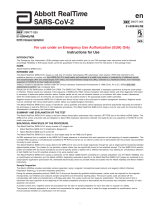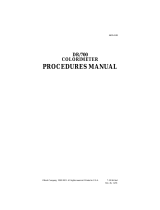Page is loading ...

INSTRUCTIONS
Pierce Biotechnology
PO Box 117
(815) 968-0747
www.thermoscientific.com/pierce
3747 N. Meridian Road
Rockford, lL 61105 USA
(815) 968-7316 fax
Number Description
26134
ML(PEG)
4
, 100mg
Molecular Weight: 395.58
Spacer Arm Length: 23.6Å
26135
CL(PEG)
12
, 100mg
Molecular Weight: 806.03
Spacer Arm Length: 55.5Å
Storage: Upon receipt store at 4°C protected from moisture. Products shipped at ambient temperature.
Introduction
The Thermo Scientific ML(PEG)4 (methyl-PEG4-lipoamide) and CL(PEG)12 (carboxy-PEG12-lipoamide) are bidentate thiol-
terminated polyethylene glycol (PEG)-containing reagents with either a methyl ether or carboxylic acid. These reagents are
used for modifying surfaces such as quantum dots, self-assembled monolayers, and magnetic particles. Functionalization of
solid surfaces, such as quantum dots and silver and gold surfaces with polyethylene glycol spacers significantly reduces
nonspecific protein binding.1-6
The use of ML(PEG)4 with CL(PEG)12 in surface modification can form a hydrophilic “lawn” of methyl ether-terminated
PEGs with periodic exposed carboxy-containing PEGs. The exposed carboxylic acid groups can be coupled to affinity
ligands using the carbodiimide coupling reaction with EDC and sulfo-NHS.
Typical PEG reagents contain heterogeneous mixtures of different PEG chain lengths; however, our PEG reagents are
homogenous compounds of defined molecular weight and spacer length, providing precision in modification applications.
Figure 1. Surface modification with ML(PEG)4 and CL(PEG)12.
2342.0
26134 26135
ML(PEG)
4
CL(PEG)12
Methyl- and carboxy-lipoamide PEGylation reagents

Pierce Biotechnology
PO Box 117
(815) 968-0747
www.thermoscientific.com/pierce
3747 N. Meridian Road
Rockford, lL 61105 USA
(815) 968-7316 fax
2
Important Product Information
• Use ML(PEG)4 and CL(PEG)12 in combination to modify surfaces and minimize nonspecific binding.
• The PEG-lipoamide reagents are low-melting solids that are difficult to weigh and dispense. To facilitate handling, make
a stock solution by dissolving the reagent with dimethylsulfoxide (DMSO) or dimethylformamide (DMF).
• Store unused stock solution at -20°C. Equilibrate reagent vial to room temperature before opening to avoid moisture
condensation. To minimize air exposure, keep the stock solution under an inert gas such as argon or nitrogen. Cap the
stock solution with a septum and use a syringe to remove the solution.
• The ratio of ML(PEG)4 to CL(PEG)12 and the mixture-to-surface ratio affect the number of carboxylic acid residues
available for further modification. Optimize these ratios to obtain the ideal modification level for the specific application.
• Use non-amine-containing buffers at pH 7-9 such as phosphate-buffered saline (PBS; 20mM sodium phosphate,
150mM NaCl; pH 7.4; Product No. 28372), carbonate/biocarbonate (100mM) or borate (50mM). Do not use buffers that
contain primary amines, such as Tris or glycine, which compete with acylation.
Procedure for coupling PEG-lipoamide reagents to a surface
Materials Required
• Water-miscible organic solvent (molecular sieve-treated) such as DMSO or DMF
• Small-volume, non-coring syringes for dispensing the stock solution while minimizing exposure to air
• Buffer A: Phosphate-buffered saline, PBS (20mM sodium phosphate, 0.15M NaCl; pH 7.2, Product No. 28372) or other
non-amine, lone-pair, sulfur-free buffer.
• Buffer B: MES-buffered saline (0.1M MES, 0.5M NaCl; pH 6.0 or 0.1M MES, 0.9% NaCl; pH 4.7; Product No. 28390)
or other non-amine, non-carboxy, lone pair sulfur-free buffers.
• EDC (Product No. 77149)
• NHS or Sulfo-NHS (Product No. 24500 and 24510, respectively)
• Hydroxylamine•HCl (Product No. 26103)
Procedure
1. Equilibrate ML(PEG)4 and CL(PEG)12 to room temperature before opening bottles.
2. Prepare stock solutions by dissolving 100mg of each PEG-lipoamide reagent in the desired amount of dry water-miscible
solvent (e.g., DMF or DMSO).
3. Cap, store and handle stock solutions as directed in the Important Product Information Section.
4. Prepare the surface in Buffer A.
5. Prepare a mixture of ML(PEG)4 and CL(PEG)12 in Buffer A and add it to the surface. Incubate the reaction for 2 hours at
room temperature.
6. Wash the surface with Buffer A to remove excess reagent.
7. The newly introduced carboxylic acid groups can be activated by adding appropriate amounts of EDC and NHS or sulfo-
NHS to the modified surface in Buffer B and reacting for 15 minutes at room temperature. For best results, perform this
reaction at pH 5-6.
Note: The activation reaction with EDC and sulfo-NHS is most efficient at pH 4.5-7.2; however, the reaction of sulfo-
NHS-activated molecules with primary amines is most efficient at pH 7-8.
8. Wash the surface with Buffer B to remove any remaining EDC and NHS.
9. Add the desired amine-containing substrate, prepared in Buffer A, to the activated surface and react for 2 hours at room
temperature. For best results, raise the pH of the reaction solution to 7.2-7.5 with Buffer A immediately before adding
the amine-containing substrate.
10. To quench the conjugation reaction, add hydroxylamine or other amine-containing buffer. Hydroxylamine hydrolyzes
non-reacted NHS. Other quenching compounds include Tris, lysine, glycine or ethanolamine; however, these primary
amine-containing compounds modify carboxylic acids.

Pierce Biotechnology
PO Box 117
(815) 968-0747
www.thermoscientific.com/pierce
3747 N. Meridian Road
Rockford, lL 61105 USA
(815) 968-7316 fax
3
Related Thermo Scientific Products
20688 Dimethylsulfoxide (DMSO), Sequanal grade, 950mL
20673 Dimethylformamide (DMF), Sequanal grade, 50mL
26132 MT(PEG)4 (methyl-PEG4-thiol), 100mg
26133 CT(PEG)12 (carboxy-PEG12-thiol), 100mg
28390 BupH™ MES Buffered Saline, 10 packs, makes 5L
28372 BupH Phosphate Buffered Saline, 40 packs, makes 20L
77149 EDC, 10mg
24500 NHS (N-hydroxy succinimide), 25g
24510 Sulfo-NHS (sulfo N-hydroxy succinimide), 500mg
20290 DTT, 5g
20291 DTT, No-Weigh™ Format, 48 tubes × 7.7mg
26103 Hydroxylamine, 25g
References
1. Prime, K.L. and Whitesides, G.M. (1991). Self-assembled organic monolayers: model systems for studying absorption of proteins at surfaces. Science
252:1164.
2. Bentzen, E.L., et al. (2005). Surface modification to reduce non-specific binding of quantum dots in live cell assays. Bioconjugate Chem 16:1488-94.
3. Lin, P-C., et al. (2006). Ethylene glycol-protected magnetic nanoparticles for a multiplexed immunoassay in human plasma. Small 2(4):485-9.
4. Zheng, M., et al. (2003). Ethylene glycol monolayer protected nanoparticles for eliminating nonspecific binding with biological molecules. J Am Chem
Soc 125:7790-1.
5. Verma, A. and Rotello, V.M. (2005). Surface recognition of biomacromolecules using nanoparticle receptors. Chem Commun 3:303-12.
6. Kidambi, S., et al. (2004). Selective depositions on polyelectrolyte multilayers: self-assembled monolayers of m-dPEG acid as molecular template. J
Am Chem Soc 126:4697-03.
This product (“Product”) is warranted to operate or perform substantially in conformance with published Product specifications in effect at the time of sale,
as set forth in the Product documentation, specifications and/or accompanying package inserts (“Documentation”) and to be free from defects in material and
workmanship. Unless otherwise expressly authorized in writing, Products are supplied for research use only. No claim of suitability for use in applications
regulated by FDA is made. The warranty provided herein is valid only when used by properly trained individuals. Unless otherwise stated in the
Documentation, this warranty is limited to one year from date of shipment when the Product is subjected to normal, proper and intended usage. This
warranty does not extend to anyone other than the original purchaser of the Product (“Buyer”).
No other warranties, express or implied, are granted, including without limitation, implied warranties of merchantability, fitness for any particular
purpose, or non infringement. Buyer’s exclusive remedy for non-conforming Products during the warranty period is limited to replacement of or
refund for the non-conforming Product(s).
There is no obligation to replace Products as the result of (i) accident, disaster or event of force majeure, (ii) misuse, fault or negligence of or by Buyer, (iii)
use of the Products in a manner for which they were not designed, or (iv) improper storage and handling of the Products.
Current product instructions are available at www.thermoscientific.com/pierce. For a faxed copy, call 800-874-3723 or contact your local distributor.
© 2011 Thermo Fisher Scientific Inc. All rights reserved. Unless otherwise indicated, all trademarks are property of Thermo Fisher Scientific Inc. and its
subsidiaries. Printed in the USA.
/












